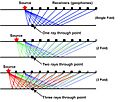Geophone facts for kids
A geophone is a special tool that helps scientists study the Earth. It's like a super sensitive ear that listens to tiny vibrations and movements in the ground. These movements can be caused by earthquakes, but also by other things like explosions or even people walking! Geophones work by turning ground movement into a small electrical signal, which can then be recorded and studied.
Contents
What is a Geophone?
A geophone is a device used to measure vibrations or movements in the ground. The word "geo" means Earth, and "phone" means sound or voice, so it literally means "Earth sound." These devices are very sensitive. They can detect even tiny shakes that we might not feel.
How Does a Geophone Work?
Geophones work using a simple but clever principle. Inside a geophone, there is usually a coil of wire and a magnet. One of these parts is fixed to the geophone's case, which sits on the ground. The other part is suspended by springs, allowing it to move freely.
When the ground shakes, the geophone's case moves with it. However, the suspended part (either the coil or the magnet) tends to stay still for a moment due to inertia. This difference in movement between the fixed part and the suspended part creates a small electrical voltage in the coil. The stronger the ground movement, the larger the voltage signal produced. This signal is then sent to a recording device, like a seismograph, which creates a record of the ground's vibrations.
What are Geophones Used For?
Geophones are incredibly useful tools in many fields of science and engineering.
Studying Earthquakes
One of the most important uses of geophones is in seismology, the study of earthquakes. When an earthquake happens, it sends out waves of energy through the Earth. Geophones placed in different locations can detect these waves. By analyzing the signals from many geophones, scientists can figure out where an earthquake started (its epicenter), how strong it was, and how deep it occurred. This helps us understand more about our planet and predict future seismic activity.
Exploring for Resources
Geophones are also widely used in the search for natural resources like oil, natural gas, and minerals. Scientists create small vibrations in the ground, often by using special trucks that create thumps or by setting off small explosions. These vibrations travel through the Earth and bounce off different layers of rock. Geophones placed on the surface listen for these reflected waves. By studying how the waves travel and bounce back, scientists can create detailed maps of what's underground. This helps them find places where oil or gas might be trapped.
Other Uses
- Monitoring Volcanoes: Geophones can detect ground movements around volcanoes, which can be a sign that a volcano is becoming active.
- Construction and Engineering: They are used to check the stability of buildings, bridges, and other structures, and to monitor vibrations from construction work.
- Environmental Studies: Geophones can help monitor landslides or the movement of glaciers.
- Archaeology: Sometimes, geophones are used to find buried ancient structures or artifacts by detecting changes in the ground's density.
Images for kids
See also
 In Spanish: Geófono para niños
In Spanish: Geófono para niños





